Sourdough Pizza Crust
Sourdough Pizza Crust makes everyone’s favorite food even better. It takes several hours to make the dough, but the vast majority of the time is hands-off.
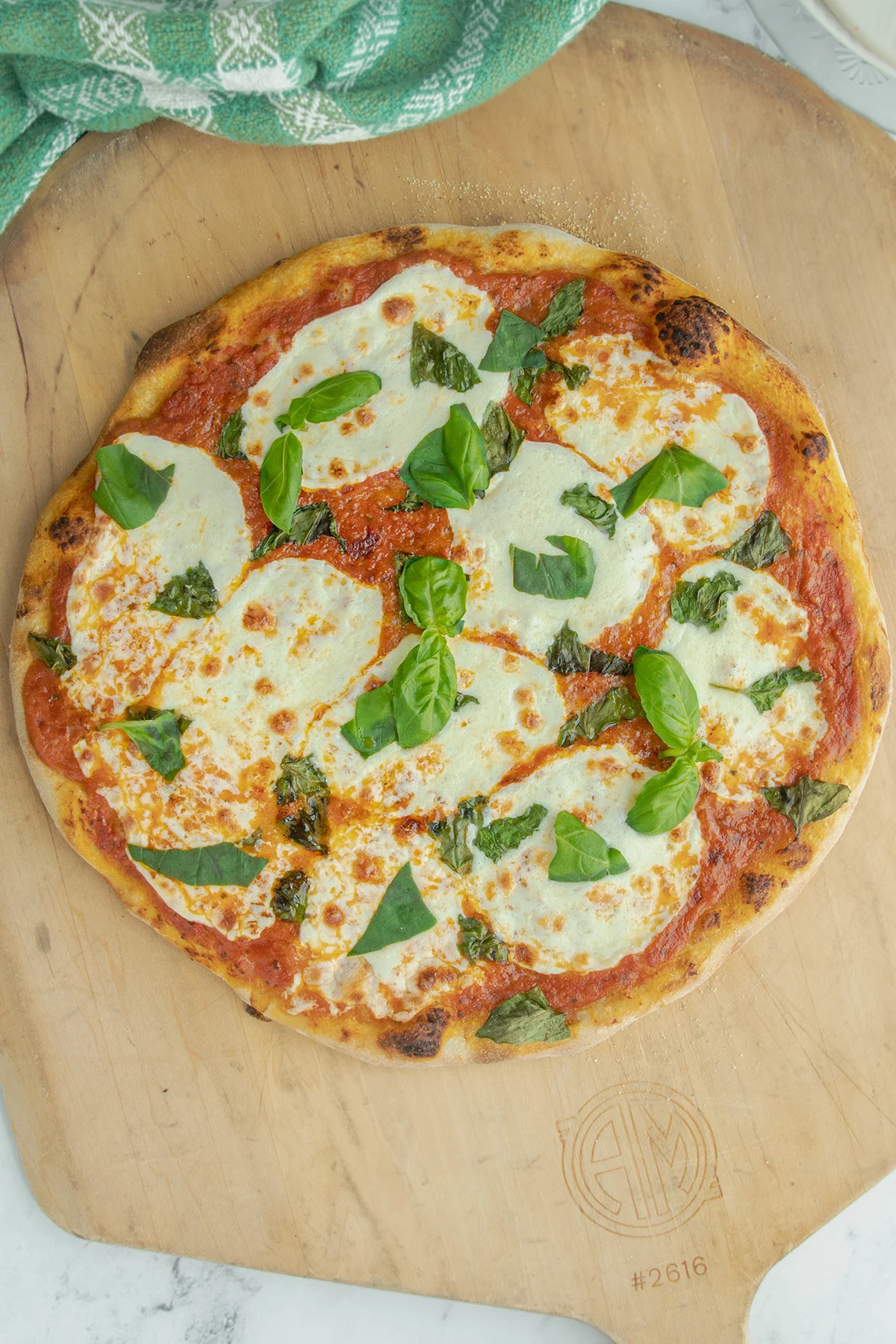
If you still need to make your sourdough starter, go ahead and use this recipe for Easy Pizza Dough in the meantime.
You can learn How to Make a Sourdough Starter for next time. Then I can show you how to Feed and Maintain Sourdough Starter or How to Keep a Small Sourdough Starter.
An overview of this recipe is also available as a web story.
Now, for those of you who are ready to make the best pizza of your life, lets see how to do it.
Recipe Ingredients
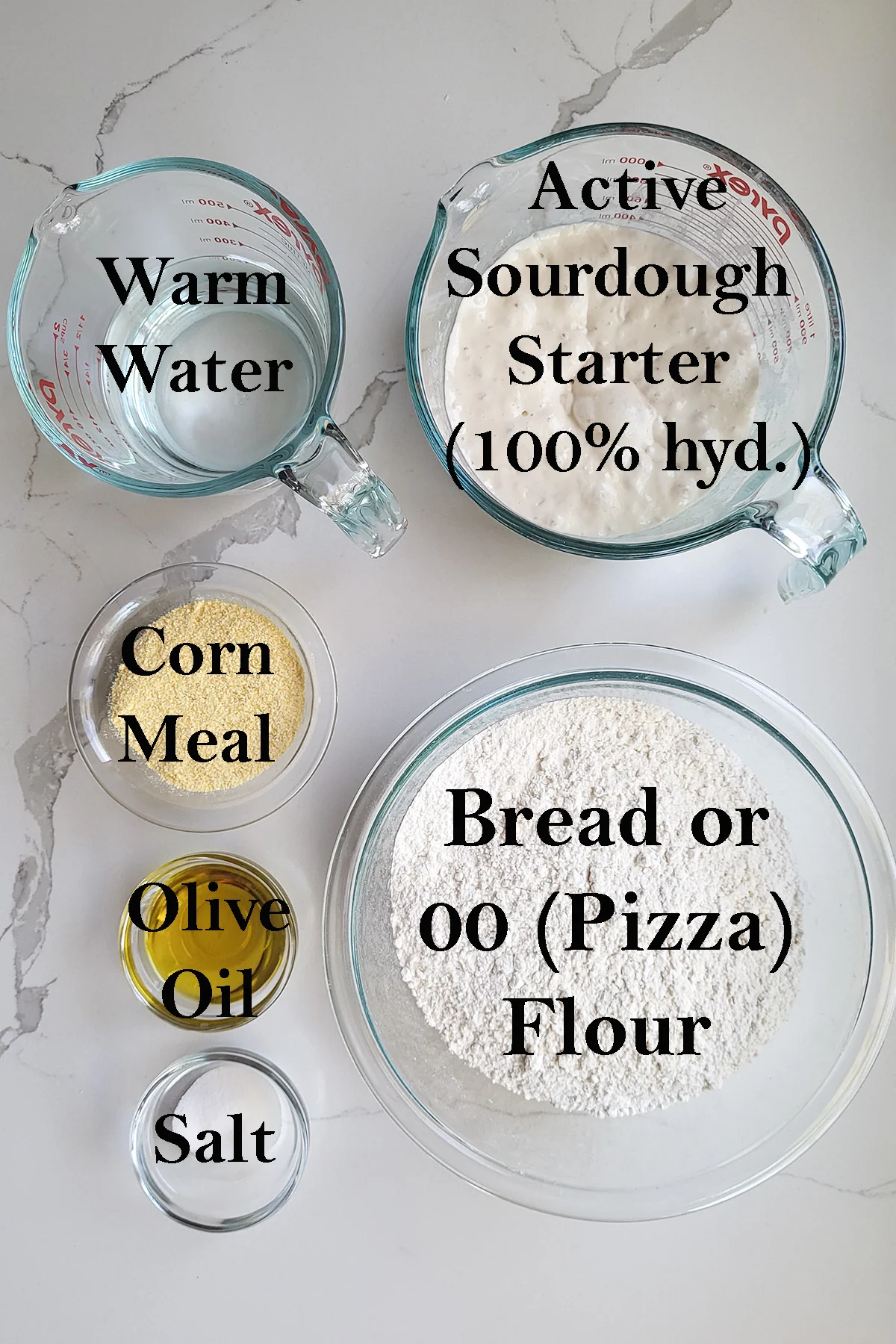
- Active sourdough starter (100% hydration)
- Warm water
- Unbleached Bread flour (see Tips and Tricks below for alternate flour options)
- Salt
- Olive oil
- Cornmeal
How to make the best Sourdough Pizza Crust:
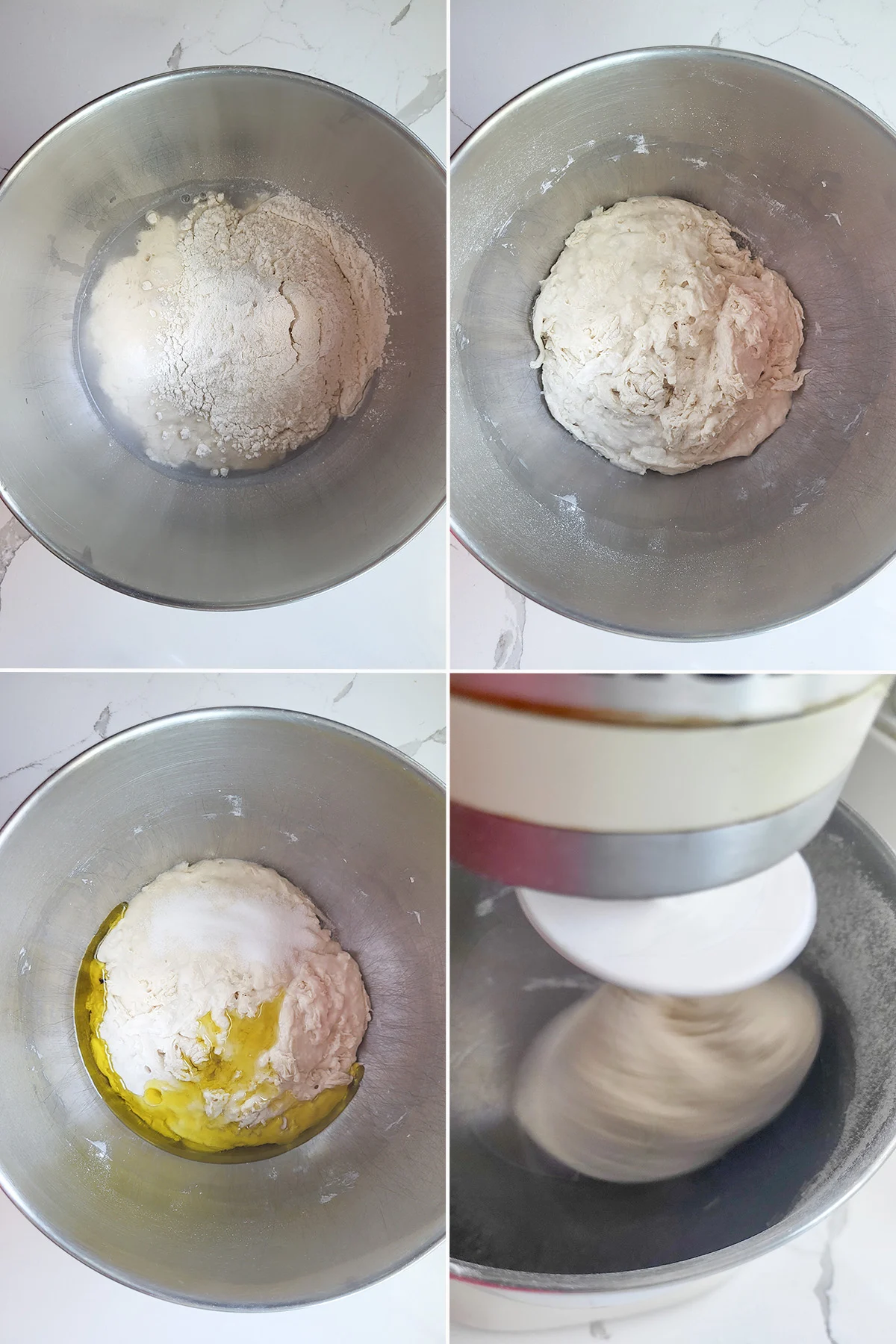
- Start with an active starter. Add the water and some of the flour to make a sponge.
- Allow the sponge to rest for 30-60 minutes before mixing the dough.
- Add olive oil, salt and the rest of the flour to the dough.
- Knead with the dough hook for 5 minutes. The dough should gather on the hook and clear the sides of the bowl. Alternately, mix and knead the dough by hand.
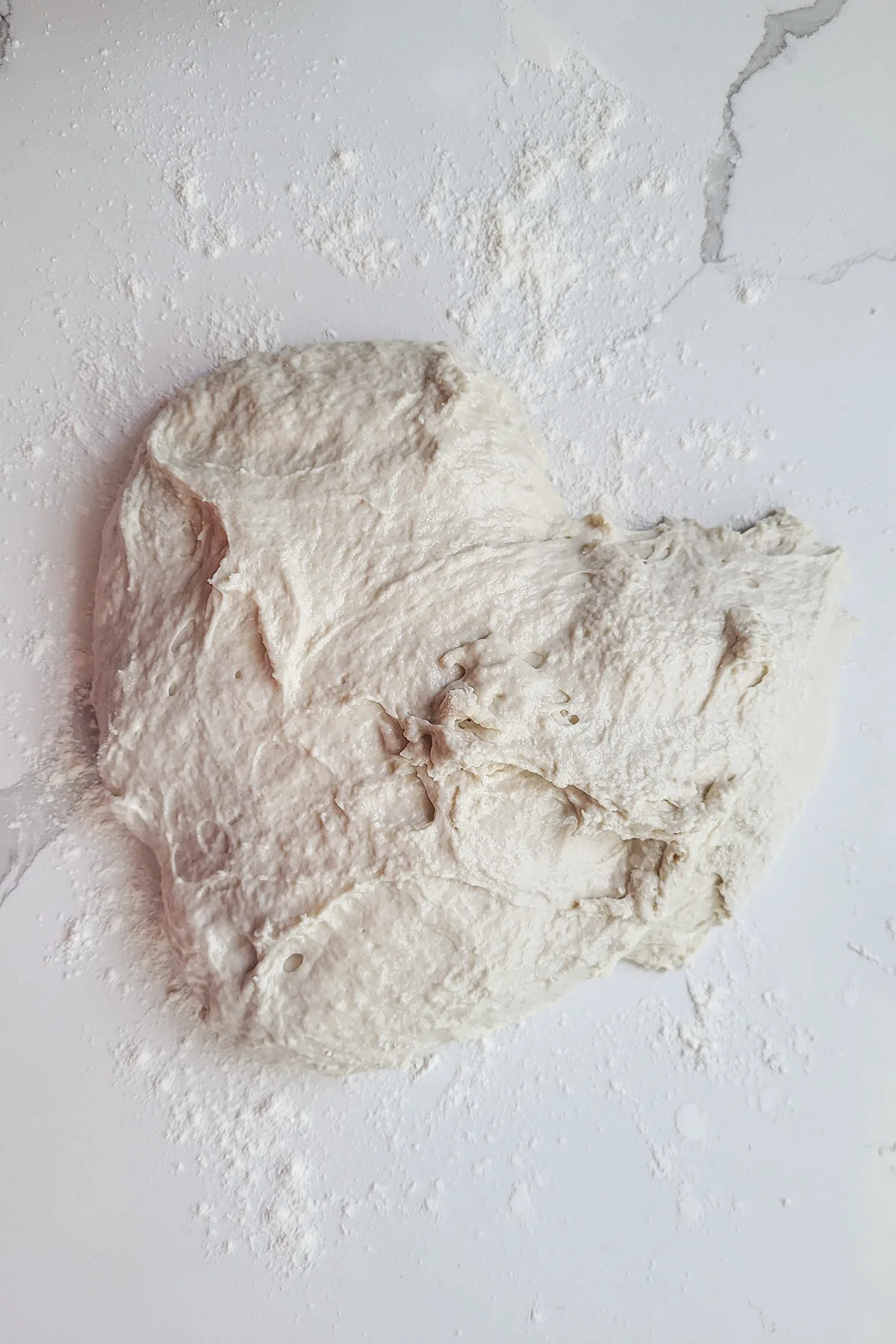
- The dough will be quite sticky right after it’s mixed.
- The dough will become more elastic and cohesive over the 3-5 hours of fermentation.
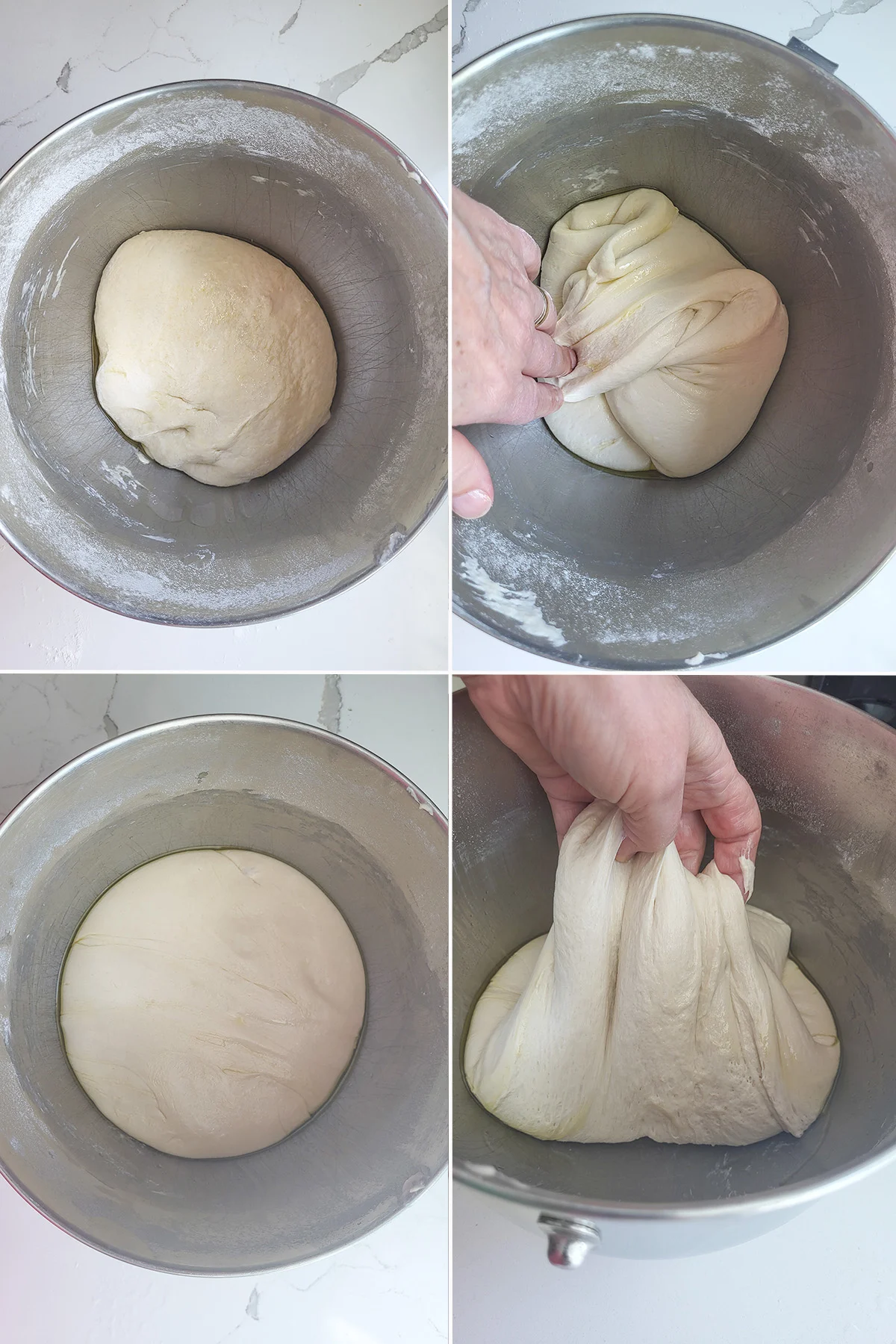
- Over 3-4 hours of fermentation the dough will become lighter and more elastic.
- Every hour of so stretch and fold the dough to redistribute the yeast and aerate the dough.
- After fermentation the dough should be aerated and elastic. It’s ready to shape or the dough can be refrigerated for up to 2 days before using.
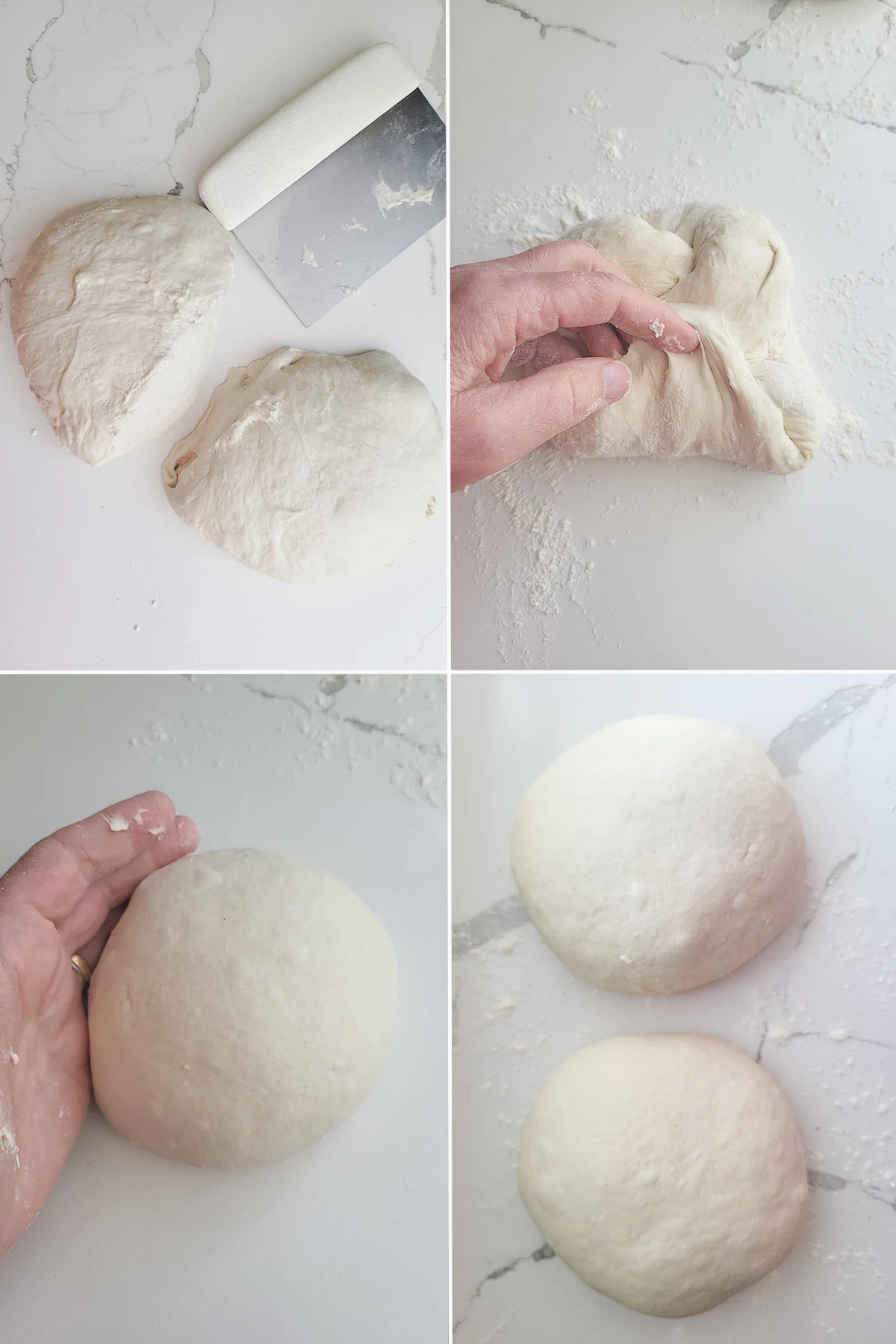
- Divide the dough into two equal portions
- Fold piece of dough onto itself for form a small packet.
- Flip the dough over and form the dough into a tight ball.
- Let the dough balls rest for at least 10 minutes and up to 30 minutes before shaping.
- Once the dough is ready, visit this post to see exactly how to shape pizza dough by hand.
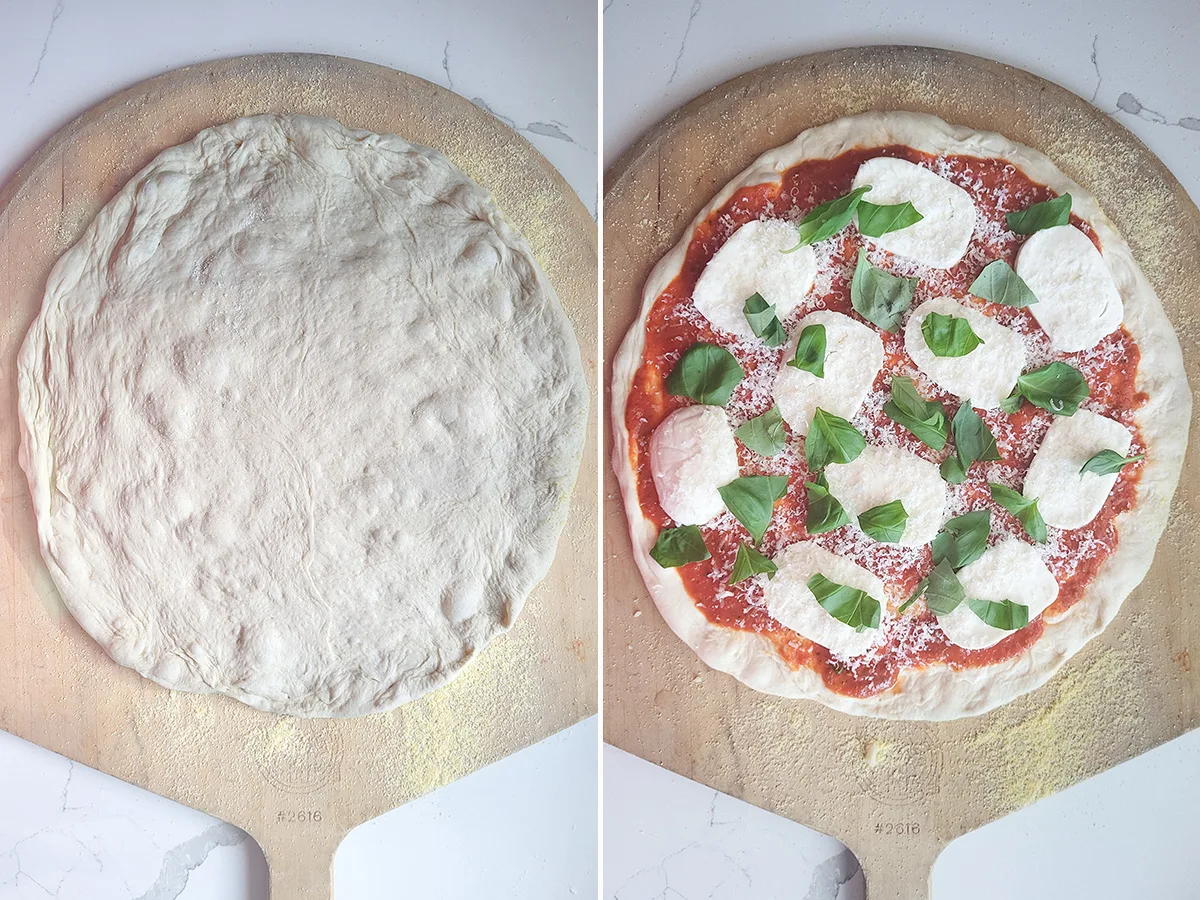
- Place the dough onto a wooden pizza peel or the back of a sheet pan heavily dusted with cornmeal. The cornmeal will act as ball-bearings so you can slide the pizza. You’re now ready to top and bake (or grill) your pizza.
- You can bake your sourdough pizza dough in a very hot oven, or you can grill your pizza over charcoal for the best pizza in the world. The lightly charred crust is a thing of beauty!
Recipe Tips and Tricks
- Make sure your starter is fed and very active before mixing the dough.
- This sourdough pizza dough recipe was developed using a 100% hydration starter. You’ll need to adjust the water or flour if your starter is not 100%.
- This recipe was developed using unbleached bread flour. The recipe also works well with semolina or 00 pizza flour.
- If you want to work ahead, you can make the dough, allow it to ferment and then refrigerate for up 2 days. Take the dough out of the refrigerator and go right ahead and shape the pies.
A timeline for making Sourdough Pizza Crust from scratch:
- Feed your starter the day before or early in the morning of the day you want to make the dough. You want to make the dough with an active starter.
- Make the dough in the late morning or early afternoon. The entire process can take up to 5 hours so allow enough time if you plan to use the dough the same day it is made.
- The dough will ferment for about 3-5 hours over the course of the afternoon. The more active your starter is and the warmer the ambient temperature, the faster the dough will ferment. In cold months allow closer to 5 hours for fermentation.
- 30 minutes before you’re ready to bake (or grill!) the pizza, begin the process of shaping the dough.
Recipe FAQs
If you add too much flour or not enough water to the dough the pizza can bake up dry and bready. A wetter dough will make a lighter and crisper crust. Do not knock all the air out of the dough before shaping. If you vigorously knead the dough before shaping you’ll end up with lots of tiny air bubbles and a bready texture.
Yes. Sourdough pizza dough can be held in the refrigerator for up to 2 days or frozen for several weeks.
There is no need to “punch down” pizza dough. After the initial fermentation gently fold and stretch the dough to redistribute the yeast. By gently folding the dough you retain some of the air bubbles that formed during fermentation and your pizza will have a lighter and crisper crust.
I know you hate to throw away that sourdough discard. Check out these recipes that use sourdough discard.
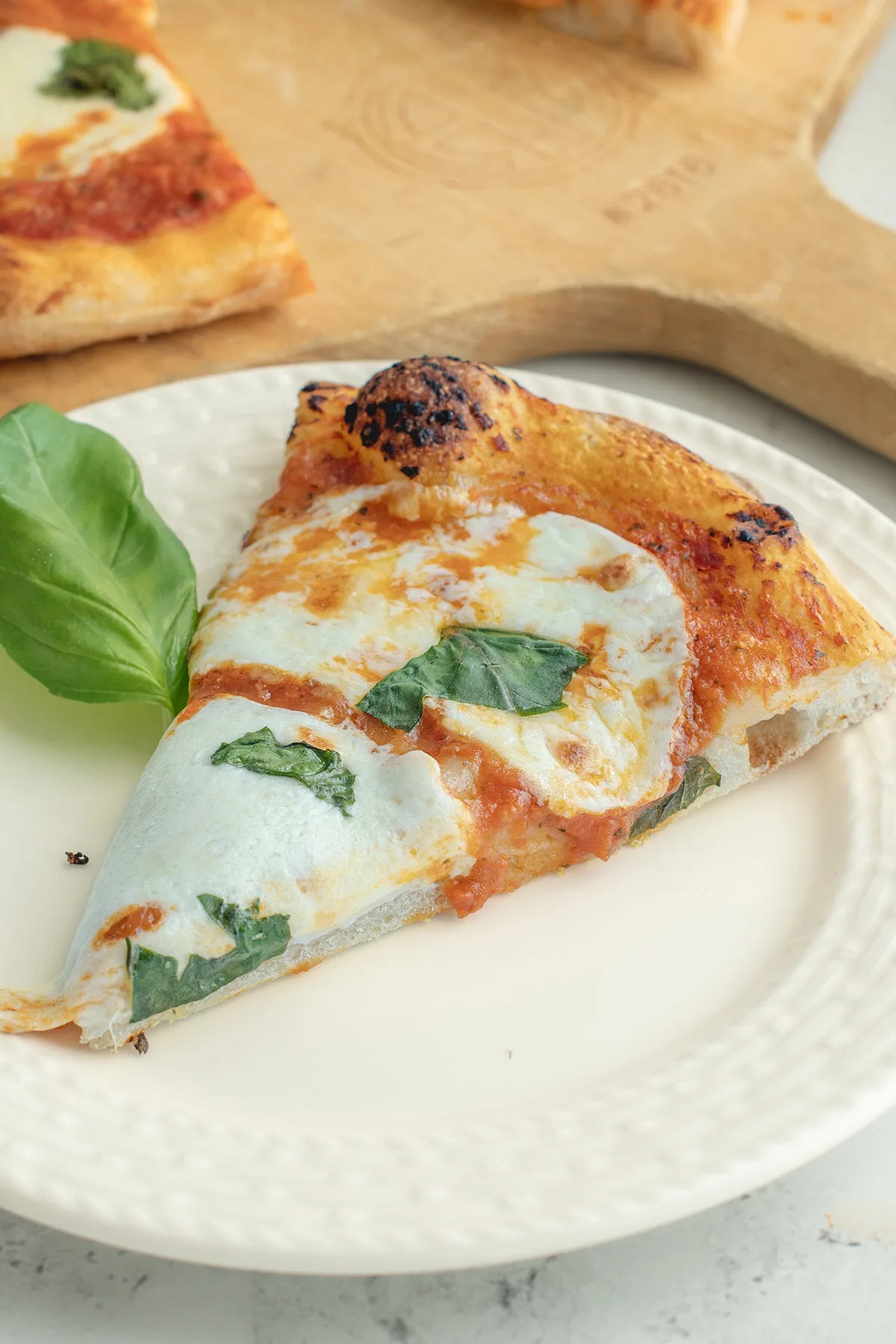

Hey, since the grill (or oven) is still hot, why not try this light & luscious Dessert Pizza with fresh berries and Greek yogurt drizzle.
You can also use this dough to make Philly Cheesesteak Calzones or Breakfast Calzones with chorizo & eggs.
Can You Freeze Sourdough Pizza Dough?
Yes, you can freeze Sourdough Pizza Dough. Make sure your starter is very active so you have plentiful yeast in the dough. Bring the dough through the initial fermentation. Form it into a tight ball, wrap it in plastic and put it into a freezer bag.
If you love this recipe as much as I do, I’d really appreciate a star rating and a quick comment. Ratings and comments help my recipes show in search results. Thanks!
Sourdough Pizza Crust Recipe
Ingredients
- 8 oz active sourdough starter (1 cup, 100% hydration)
- 8 oz warm water (1 cup)
- 15 oz bread flour (3 cups, see note)
- 1 ½ teaspoons table salt
- 1 oz olive oil (2 tablespoons)
- cornmeal for dusting
Instructions
- Combine 8 oz active sourdough starter, 8 oz warm water and 10 oz (2 cups) of the flour. Mix on low speed with the paddle until the flour is incorporated. Cover the bowl and set aside for 30 -60 minutes.
- If using a stand mixer, change to the dough hook. With the mixer running on low, add 1 ½ teaspoons table salt, 1 oz olive oil and the remaining the flour. Mix on medium speed until the dough begins to clear the sides of the bowl and gathers on the hook. Increase the speed to medium-high and knead for 5 minutes. If mixing by hand add as much of the flour as you can using a spoon or spatula, then turn the dough out onto a floured surface to finish kneading in the rest of the flour.
- Dump the dough onto a floured surface and knead into a smooth ball. Place the dough into a lightly oiled bowl and turn it over to coat the surface. Cover the bowl and set aside at room temperature.
- After 30 minutes uncover the bowl, lift one side of the dough and fold it into the middle of the dough. Repeat with the other three sides of the dough then flip the dough over. You're basically turning the dough inside-out to redistribute the yeast and stretch the gluten. Cover the bowl and after 30 minutes repeat the procedure. Cover the bowl and after 60 minutes repeat the procedure again.
- Cover the bowl and set aside for another 60 minutes. By the end of 3 hours the dough should be lively, elastic and airy. If the dough is still sluggish give it another hour at room temperature. At this point you can refrigerate the dough for up to 2 days or you can go ahead and make the pizzas.
- Dump the dough onto a floured surface, do not knead. Using a bench scraper or sharp knife, cut the dough into 2 equal pieces. Form each piece into a tight ball by cupping the dough in the palms your hands and moving the dough in a circular motion. This is a soft dough so this step will help make forming and moving the pizza easier. Cover the dough and allow it to rest for 20 minutes. If the ball flattens right away and the dough still seems very soft, form the ball again and give it another 20 minutes.
- Meanwhile, preheat the oven to 500 °F. If you have a pizza stone preheat that too. You can also bake pizza on the grill.
- Using the tips of your fingers, gently flatten and press the dough into a disc. Use your fingers to stretch the dough into a 12-14” "round. You can also try to drape the dough over your two fists and pull from the edges to slowly enlarge it to a 12" round. Avoid using a rolling pin because you don't want to deflate all the air bubbles in the dough. Visit this page to see step by step photos of how to shape pizza dough by hand.
- Place each crust onto a wooden peel or pizza pan sprinkled heavily with corn meal. Proceed to top and bake/grill or as you like.
Would you like to save this recipe?
As an Amazon Associate and member of other affiliate programs, I earn from qualifying purchases.









The new measurements are off. My dough has been turning out too dense,and I’m not crazy because I just found the old version on the wayback machine. It doesn’t seem like the small differences would change the dough, but it Reale does. I would suggest going back to what you had before.
The CORRECT measurements:
224g starter
240mL warm water
420g bread flour
These are not really new measurements. The new recipe card automatically converts the ounce measurement to gram measurements. When I did it manually I rounded up or down since many scales don’t measure down to fractions. Honestly, 2g difference is a 10th of an ounce and would not significantly change the outcome of the dough. Even a 15ml difference in the water (vs grams) is only a tablespoon of water. Again, would not significantly change the recipe.
Hi! I have made your crust weekly and am loving it! I see that you removed the grams amount in the recipe. Can you please share them with me? I do not use measuring cups when I bake. Thank you
Hi Amy, I switched to a new recipe card that automatically switches between US and metric. If you click on the button at the top to switch from US to metric you’ll get the gram measurements. The same button also switches from F to C temperatures.
@Eileen Gray, The button isn’t working. 🙁
@Eileen Gray, The gram conversion is completely different than before. I know some of the measurements because I made it so often.
I’m sure it’s close enough. When I manually convert oz to grams I use 28.3g per ounce but would usually round up or down to 5g since many scales measure in 5g increments. Such small differences won’t make a difference in the dough.
@Amy, there is definitely something off. I use this recipe quite often as well, and the last two times I’ve made it, the dough has been way too dense.
I make my pizza crust almost weekly in the summer and the difference of 1 or 2 grams with the new conversion on the recipe card would not significantly change the recipe.
@Kayla, I agree! It’s making a big difference. Thank you for posting the correct measurements. 🙂
If I want to put the dough in the fridge for tomorrow, do I wrap it tight on plastic or leave on the bowl with the beautiful bubbles
I leave it in the bowl with the bowl covered with plastic wrap. If you oil the bowl and the dough has a light coating of oil you’ll avoid the top of the dough drying out.
This has got to be one of the biggest failure of pizza dough that I’ve ever made. I followed the recipe and instructions weighing all my ingredients, and after adding the 3rd cup of flour (I used type 00), the dough was very wet and goopy. I knew that it wasn’t right, so I added more flour a tablespoon at a time to get it to pull away from the bowl. After adding about another 1/2 c flour, it at least was clinging to the dough hook, so I let it knead for the 5 min. When I poured (yes, poured) it out of the bowl, it resembled muffin batter. It held a very loose shape, but I could not touch it without it sticking to everything – the counter, my hands, and the scraper. I kept adding flour and using the scraper to try to get it to hold a ball shape. I probably added another 1/2 cup of flour, but started to get worried about another 1 cup of flour, so I dumped it into the oiled bowl and tried to turn it over. I tried to pull the dough over itself at the intervals, it was very sticky and gooey, and it would basically just ooze back to the sides. After the 3 hours, I knew that there was no way that this would be able to be shaped into pizza dough, so I covered it and put it into the fridge. In the morning, it looked a lot better, and it was very cold, so it held it’s shape, but when I tried to cut it, it was still very sticky. I decided to just keep adding flour until I could handle it, and I got it to a point of being able to shape the balls if I floured my hands. I make Neapolitan pizza all the time, and I have an outdoor pizza oven. I usually make 250g dough balls, these were weighing over 400g, so I split the dough into 3 300g balls – one being a little over. I put a lot of flour in the proofing box and sprinkled more on top to let them rest for the 20m. It definitely didn’t look ready, so I let the dough rise again for over an hour. When I stretched the first one (with a lot of flour), it got holes in it. On the 2nd one, I was more careful. I was able to stretch the 3 pizzas, they were about 10″ round. The crust was very crisp. I wish I knew what I did wrong, I’d be scared to try it again.
Most likely it has to do with the condition of your starter. I make this dough all the time and it works like a dream for me. Make sure your starter is at 100% hydration and that it is well-fed and lively. Also, might be obvious, but I assume you were using bread flour, not ap flour.
@Lynne, use much less water for type 00 as it’s a delicate flour or try flour with higher gluten like strong white which is very forgiving
@Eileen Gray, can you use AP flour?
In a jam you can use AP flour. You’ll probably need extra flour because lower protein AP flour will absorb less water than higher protein bread flour.
@Shirley,
I made dough using AP flour and it was delish! I will us bread flour next time to compare! Excellent recipe!
Can this dough be frozen?
I have frozen this dough.